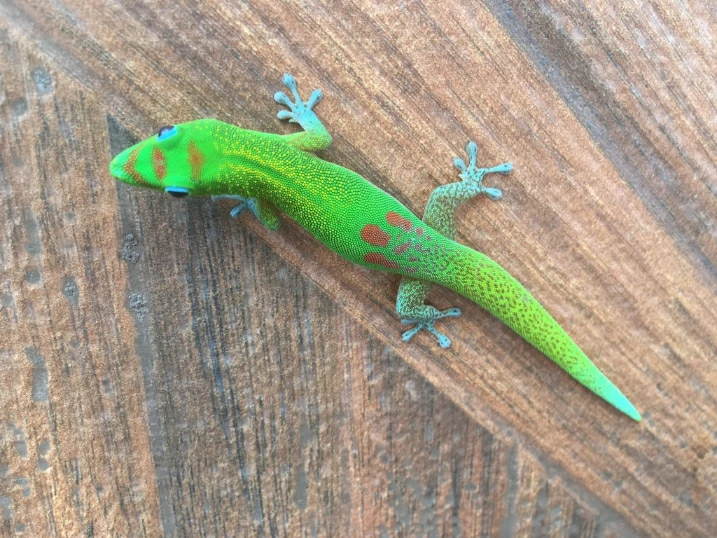If you’ve ever watched a gecko on a wall at night, you’ll see quick movements, tiny flicks of the tongue, and sudden pounces. They’re small, but those eyes and fast legs mean one thing: they’re hunting.
So what exactly do geckos eat in the wild?
Wild geckos eat a mix of insects, spiders, worms, and sometimes tiny animals like baby lizards or frogs. Most species go after insects, catching whatever moves nearby, moths, crickets, mosquitoes, beetles, ants, or termites. Larger geckos can eat even more, including scorpions and small birds.
They’re natural pest controllers, surviving on speed, patience, and a sharp sense for movement that few animals can match.
Most Geckos Hunt at Night
Wild geckos are mostly active at night, when insects are out and it’s cool enough to move safely.
Their big eyes gather more light than ours, letting them see clearly in near darkness.
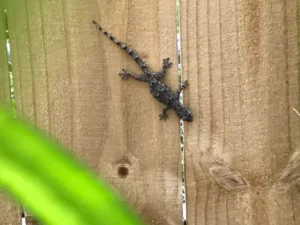
They sit near lamps, windows, or tree trunks where bugs gather, waiting quietly for the perfect moment to strike.
When something moves a mosquito, a moth, or a beetle) they dash, grab it with their jaws, and swallow it whole.
No chewing. No wasting time. Just quick, efficient feeding.
This instinct helps them thrive in both forests and cities. If you see a gecko near your porch light, it’s not lost, it’s having dinner.
What’s on a Gecko’s Menu?
A wild gecko’s diet depends on its size, environment, and species. But across the world, their favorite meals are pretty similar.
Here’s what most wild geckos eat:
-
Insects: Crickets, beetles, cockroaches, grasshoppers, and flies.
-
Arachnids: Spiders and, for larger species, even small scorpions.
-
Worms: Earthworms and larvae that live in soil or under bark.
-
Other small prey: Baby geckos, frogs, or small lizards for big hunters like tokay geckos.
-
Occasional fruit or nectar: Some species, especially day geckos, also lick ripe fruit and flower nectar for extra energy.
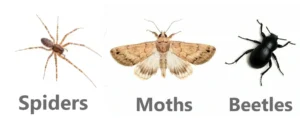
Still, most geckos prefer moving meals. A tiny twitch is all it takes to trigger their hunting instinct.
How Geckos Hunt in the Wild
Geckos are patient hunters. They rely on stealth, speed, and sharp vision.
At night, they cling quietly to surfaces using tiny hairs on their toes called setae. These hairs stick even to smooth glass, letting geckos walk upside down or sideways while stalking prey.
Once they spot a target, their pupils widen, their body tenses, and in one sudden lunge, snap, the prey is gone.
Their tongues help pull small insects into their mouths, and their strong jaws crush the shells easily. Some species even make soft clicking sounds while hunting, as if getting ready for the strike.
Do All Geckos Eat the Same Things?
Not quite. Wild geckos live all over the world, from tropical rainforests to deserts and cold mountain slopes. What they eat depends on what’s available.
-
Tropical geckos like day geckos and house geckos eat insects, fruit, and nectar.
-
Desert geckos, like the web-footed gecko, mostly eat beetles, termites, and ants.
-
Forest geckos hunt worms, moths, and caterpillars under bark or in leaf litter.
-
Urban geckos thrive on mosquitoes, roaches, and flies near houses and lights.
So while all geckos share the same hunting instincts, their diets are shaped by where they live.
How Often Do Wild Geckos Eat?
Geckos eat often, but not all the time.
In the wild, food isn’t always around, so they eat well when they can and wait when they can’t.
Small geckos may hunt every night, while larger ones can go days without food after a big meal.
They store extra fat in their tails, which acts like backup energy. During cold nights, dry seasons, or when insects are scarce, that tail fat keeps them alive.
If a predator grabs their tail, they drop it and escape, but they lose that stored energy too. That’s why a tailless gecko often hunts more aggressively afterward.
How Geckos Catch Flying Insects
Flying prey is tricky, but not for a gecko.
They sit near lights, tree sap, or open windows where moths gather. Then they leap with amazing precision, guided by timing and depth perception.
Some even use their tails to balance mid-air as they strike.
Once the prey is caught, they land smoothly and swallow quickly before it can escape.
Even tiny geckos, barely an inch long, start practicing these leaps within days of hatching.
Do Wild Geckos Ever Eat Fruit?
Most geckos eat only animals, but a few, like day geckos, are different.
They live in humid, tropical places where fruit and flowers are everywhere.
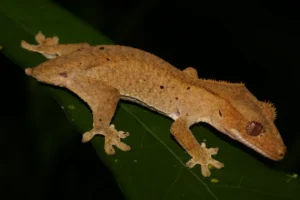
You’ll often see them licking ripe mangoes, bananas, or flower nectar. Fruit gives sugars and vitamins, and nectar provides quick energy.
Even these geckos still eat insects because they need protein for muscles and skin. So they’re not vegetarians, they just have a bigger menu.
How Much Can a Gecko Eat?
You might be surprised how much a small gecko can eat when it’s hungry.
A common house gecko can eat 20 or more insects a night, especially during warm seasons when bugs are plentiful.
They don’t chew, they swallow prey whole. Bones, shells, and wings are broken down in the stomach by strong acids.
After feeding, geckos often rest to help digest their food, soaking up warmth from the environment to break it down faster.
Do Geckos Eat Each Other?
It sounds brutal, but yes.
Large geckos sometimes eat smaller ones, especially if food is scarce or territories overlap.
Tokay geckos, one of the biggest species, are territorial and aggressive. If another gecko wanders too close, it may become a meal.
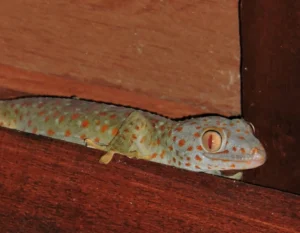
It’s not cruelty, it’s survival. In the wild, every advantage counts, and size often decides who eats and who hides.
Why Geckos Eat So Many Pests
Geckos thrive near humans because our homes attract the same insects they love.
Lights draw moths, mosquitoes, and flies, perfect hunting spots for house geckos. They sit near lamps, ceilings, or windows, waiting quietly.
Within minutes, they start catching insects that would otherwise bother us.
That’s why people in tropical regions welcome geckos, they’re quiet, harmless, and excellent pest control.
Do Wild Geckos Drink Water or Get It from Food?
Both.
Wild geckos lick dew drops, rainwater, or condensation on leaves and walls. They also get moisture from insects, many bugs are up to 70% water.
In dry areas, geckos rely heavily on this internal water. Desert species often hunt early morning or late evening when dew is present.
Their tongues are shaped perfectly to lap up even tiny drops.
What Happens When Food Is Scarce?
When insects disappear during cold or dry seasons, wild geckos slow down.
They hide in cracks, under rocks, or in tree holes, moving very little to save energy. The fat in their tails keeps them alive for weeks or months.
If conditions stay harsh, some go into light hibernation, reduced activity until warmth and insects return. It’s how they survive in unpredictable environments.
How Baby Geckos Learn to Hunt
Baby geckos start hunting almost immediately after hatching.
They’re fully independent, no parents feeding or protecting them. Within hours, they begin stalking tiny insects like fruit flies or ants.
Their instincts are sharp. Tongue flicks, quick pounces, and accurate aim are all built in. Each catch strengthens those reflexes, getting them ready for bigger prey as they grow.
How Wild Geckos Choose What to Eat
Geckos don’t just eat anything that moves. They choose wisely.
They prefer soft-bodied insects that are easy to digest. Hard beetles may be avoided unless they’re small. They often bite off wings or legs first to make swallowing easier.
Their sense of smell and taste helps them decide if a meal is safe. Sometimes they test by licking first, a quick chemical check.
Why Wild Geckos Are So Good at Surviving
Geckos are some of the most adaptable reptiles on Earth. Their diet flexibility helps them live in so many places.
They can eat hundreds of insect types, adjust to new environments, and even survive in cities by hunting around human lights.
As long as there are insects anywhere in the world, geckos can live there.
Conclusion
Wild geckos eat insects, spiders, worms, and sometimes small animals. They hunt at night with speed, precision, and unblinking eyes, cleaning up the insect world one meal at a time.
Their diet may seem simple, but it’s built for survival. Every movement, tongue flick, and pounce keeps them alive and keeps nature balanced.
Next time you see a gecko on your wall, think of it as a quiet night hunter doing what it’s done for millions of years: keeping the world’s bugs in check, one bite at a time.
Hi, my name is Ezra Mushala, i have been interested animals all my life. I am the main author and editor here at snakeinformer.com.

